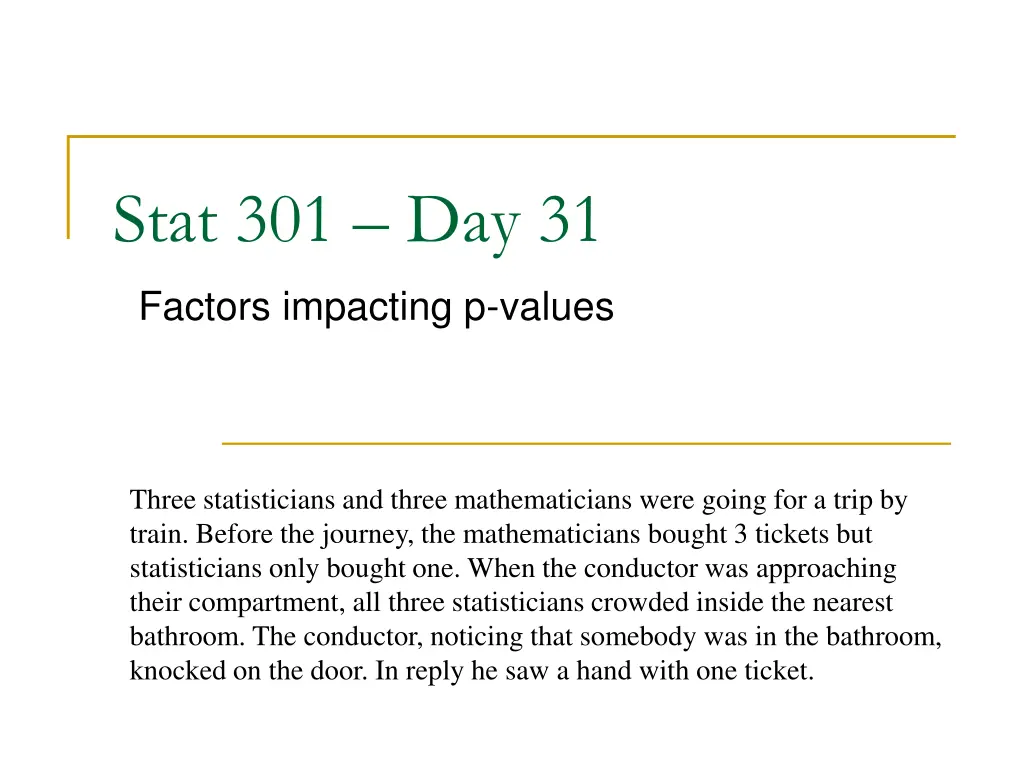
Factors Impacting P-Values in Statistical Analysis
Explore the humorous train journey of statisticians and mathematicians while uncovering the factors impacting p-values in statistical analysis. Discover the quirky scenarios that shed light on statistical concepts in an engaging manner.
Download Presentation

Please find below an Image/Link to download the presentation.
The content on the website is provided AS IS for your information and personal use only. It may not be sold, licensed, or shared on other websites without obtaining consent from the author. If you encounter any issues during the download, it is possible that the publisher has removed the file from their server.
You are allowed to download the files provided on this website for personal or commercial use, subject to the condition that they are used lawfully. All files are the property of their respective owners.
The content on the website is provided AS IS for your information and personal use only. It may not be sold, licensed, or shared on other websites without obtaining consent from the author.
E N D
Presentation Transcript
Stat 301 Day 31 Factors impacting p-values Three statisticians and three mathematicians were going for a trip by train. Before the journey, the mathematicians bought 3 tickets but statisticians only bought one. When the conductor was approaching their compartment, all three statisticians crowded inside the nearest bathroom. The conductor, noticing that somebody was in the bathroom, knocked on the door. In reply he saw a hand with one ticket.
The next day, the mathematicians decided to use the same strategy- they bought only one ticket, but the statisticians did not buy tickets at all! When the mathematicians saw the conductor, they hid in the bathroom, and when they heard knocking they handed in the ticket. They did not get it back. Why? The statisticians took it and went to the other bathroom.
Section 1 Please open R or applets page
Section 2 Please open R or applets page
Announcements Review Exam 2 scores/comments Exam avg 0.80 Dropped lowest HW, lowest quiz (6), Exam 2 15%, updated Course Avg (3/4, 80%) Solutions/video in Canvas HW 7 posted Continuing format of doing a chunk of Investigation in CourseKata so more time in class to review, practice questions
Last Week Comparing groups on quantitative response What are appropriate graphs to look at? What are appropriate statistics for summarizing the data numerically? Choice of statistic How does ?1 ?2 behave in independent random samples from two populations? Two-sample t procedures for ?1 ?2 Large populations Normal populations or large sample sizes Bootstrapping
Pooled vs. Unpooled Pooled vs. Unpooled t-test Pooled: Requires assuming population variances are equal We won t use in this course (but you will in 302) Unpooled Bootstrapping (simulation) Pool together first (H0 true) Each sample individually (confidence interval) 1 n 1 n = + ( p 1 ( p ) p ) SE p 1 2 1 2 p p p p 1 ( ) 1 ( ) = + 1 1 2 2 p p ( ) SE 1 2 n n 1 2
Elephants The difference in means (-.10) is .13 standard errors from 0 About 90% of random samples have a difference in means ( ?1 ?2) at least as large as -.10 (in either direction) when the null is true (?1 ?2= 0)
Quiz 7 Skewed data t-procedures still valid due to large sample sizes (654, 813) Parameter: Difference in mean number of close friends CI all negative values so male female Decreasing sample sizes p-value, width Two-sided p-value = 2 x one-sided p-value
Investigation 4.3 Left-handedness and life expectancy Coren and Halpern (1991) found 987 records Right handers: 75 years Left handers: 66 years Can this difference be explained by random chance (random sampling error) alone? What additional information do you need to know? Why?
Investigation 4.3 Hypotheses ?0:????? ???? ?= 0 (no association between handedness and life expectancy) ??:????? ???? ?< 0 Note: ignoring distinction between means are the same and distributions are the same
Investigation 4.3 t-statistic = -5.66, p-value < .0001 Less than 1 in 1000 (pairs of) random samples from right/left handed populations would give us a difference in sample means at least this large (> 9 years) if the population means were actually equal 95% CI: (-12.15, -5.85) I m 95% confident that the mean age of death for the population of right handers is between 5.85 and 12.15 years larger than the mean age of death for the population of left handers
Investigation 4.4 Sleep is required for memory consolidation - the process by which experience or training is transformed into improvements in performance.
Visual Discrimination Tasks a a b a b a c b c b c c
Stickgold, James, Hobson (2000) Investigated whether you can make up for a missed night s sleep 60-90 minute training sessoin Group A: Sleep deprived one night, unrestricted sleep 2 nights Group B: Unrestricted sleep all 3 nights Retested after 72 hours
Sample data Observed difference in means Unrestricted Deprived: 19.82 3.90 = 15.92 ms Is this a statistically significant difference? How large do you think the difference is in the long run?
Statistical inference Null hypothesis: There is no association between sleep condition and improvement score No tendency for more improvement, on average, for the unrestricted treatment Parameter: Let ???? ?????? represent the difference in the long-run treatment means
Simulation 21 index cards to represent the 21 subjects in the study Write the improvement scores on the cards (-10.7, 4.5, 2.2 ) to represent the treatment having no effect on the outcome Shuffle into group of 11 and 10 to represent the random assignment in the study Compute the difference in the group means Repeat many, many times
To Do Review exam comments, solutions This week: Investigations 4.4-4.6 Practice questions Friday: Investigation 4.7 Inv 4.4 practice question before tomorrow HW 7 Simulation, exact, theory-based (two-sample t)
